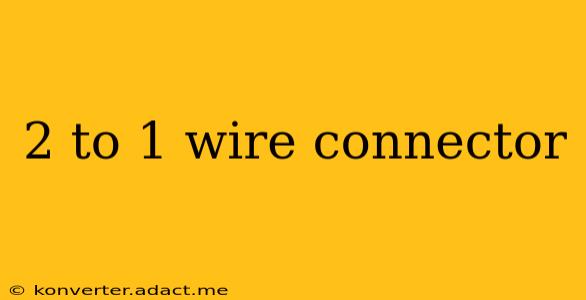Connecting two wires into one is a common task in various electrical and electronic applications. Whether you're working on a home wiring project, automotive repairs, or intricate electronics, understanding the different types of 2 to 1 wire connectors is crucial for ensuring safety and proper functionality. This guide explores the various options available, their applications, and considerations for choosing the right connector for your specific needs.
What is a 2 to 1 Wire Connector?
A 2 to 1 wire connector, also known as a wire splice or wire tap, is a device used to join two individual wires into a single, continuous electrical circuit. These connectors provide a secure and reliable connection, preventing loose wires and potential hazards. They come in various forms, each suited for different wire gauges, insulation types, and applications.
Different Types of 2 to 1 Wire Connectors
Several types of 2 to 1 wire connectors exist, each with its own advantages and disadvantages:
1. Wire Nuts (Twist-on Connectors):
These are the most common type for household wiring. Wire nuts are inexpensive, easy to use, and suitable for solid or stranded copper wires within a specific gauge range. They simply twist onto the stripped ends of the wires, creating a secure connection. However, they are not suitable for all applications, particularly those involving high vibration or harsh environments.
2. Solderless Connectors:
These connectors often utilize a spring mechanism or crimp terminals to securely connect wires without the need for soldering. They offer a more robust connection than wire nuts and are available in various sizes and configurations, making them suitable for different wire gauges. Some types are designed for quick disconnection, useful in applications where you might need to frequently disconnect and reconnect wires.
3. Crimp Connectors:
Crimp connectors use a specialized tool to create a secure mechanical connection between wires. These connectors are robust and reliable, especially in high-vibration or outdoor applications. They provide excellent conductivity and are available in various sizes to accommodate different wire gauges. Proper crimping is crucial for ensuring a reliable connection.
4. Soldering:
While not a connector in itself, soldering provides a highly reliable and durable connection. It involves melting solder onto the joined wires, creating a strong electrical bond. Soldering requires more skill and specialized tools than other methods but is often preferred for sensitive electronics or applications requiring high current capacity.
5. Terminal Blocks:
Terminal blocks are commonly used in control systems and other applications requiring multiple wire connections. They provide a secure and organized way to connect multiple wires, often with clearly labeled terminals for easy identification. They are particularly useful in industrial settings or where multiple wires need to be connected in a safe and organized manner.
How to Choose the Right 2 to 1 Wire Connector
Choosing the right connector depends on several factors:
- Wire gauge: Different connectors are designed for different wire gauges. Using the incorrect connector can lead to a loose connection or overheating.
- Wire type: Solid or stranded wire requires different connector types.
- Application: The environment in which the connector will be used (indoor, outdoor, high vibration, etc.) impacts the choice of connector.
- Current requirements: High-current applications might require more robust connectors than low-current applications.
- Ease of use: For simpler tasks, wire nuts might suffice, while more complex applications might require crimp connectors or soldering.
What are the Safety Precautions When Using 2 to 1 Wire Connectors?
- Always turn off power: Before working with any electrical connections, always disconnect the power source to prevent electric shock.
- Use the right connector: Select a connector appropriate for the wire gauge and application.
- Properly strip wires: Ensure wire ends are properly stripped to ensure good contact.
- Secure connections: Make sure all connections are secure to avoid loose wires and potential hazards.
- Follow manufacturer's instructions: Always follow the manufacturer's instructions for using specific connectors.
How to Connect Two Wires Using a 2 to 1 Wire Connector (General Instructions)
The exact process varies depending on the connector type. Refer to the manufacturer's instructions for your specific connector. General steps may include stripping the wire ends, inserting them into the connector, and securing the connection (e.g., twisting, crimping, or soldering). Always prioritize safety and use appropriate tools.
What are the Potential Problems with Poorly Connected Wires?
Poorly connected wires can lead to a variety of problems, including:
- Electrical fires: Loose connections can generate heat, potentially leading to fires.
- Intermittent connections: Loose connections can cause intermittent interruptions in the electrical circuit.
- Damage to electrical components: Poor connections can damage sensitive electronic components.
- Electric shock: Improperly connected wires can pose a risk of electric shock.
This comprehensive guide provides a solid foundation for understanding 2 to 1 wire connectors. Remember to always prioritize safety and choose the right connector for your specific needs. Consulting with a qualified electrician is recommended for complex wiring projects.
